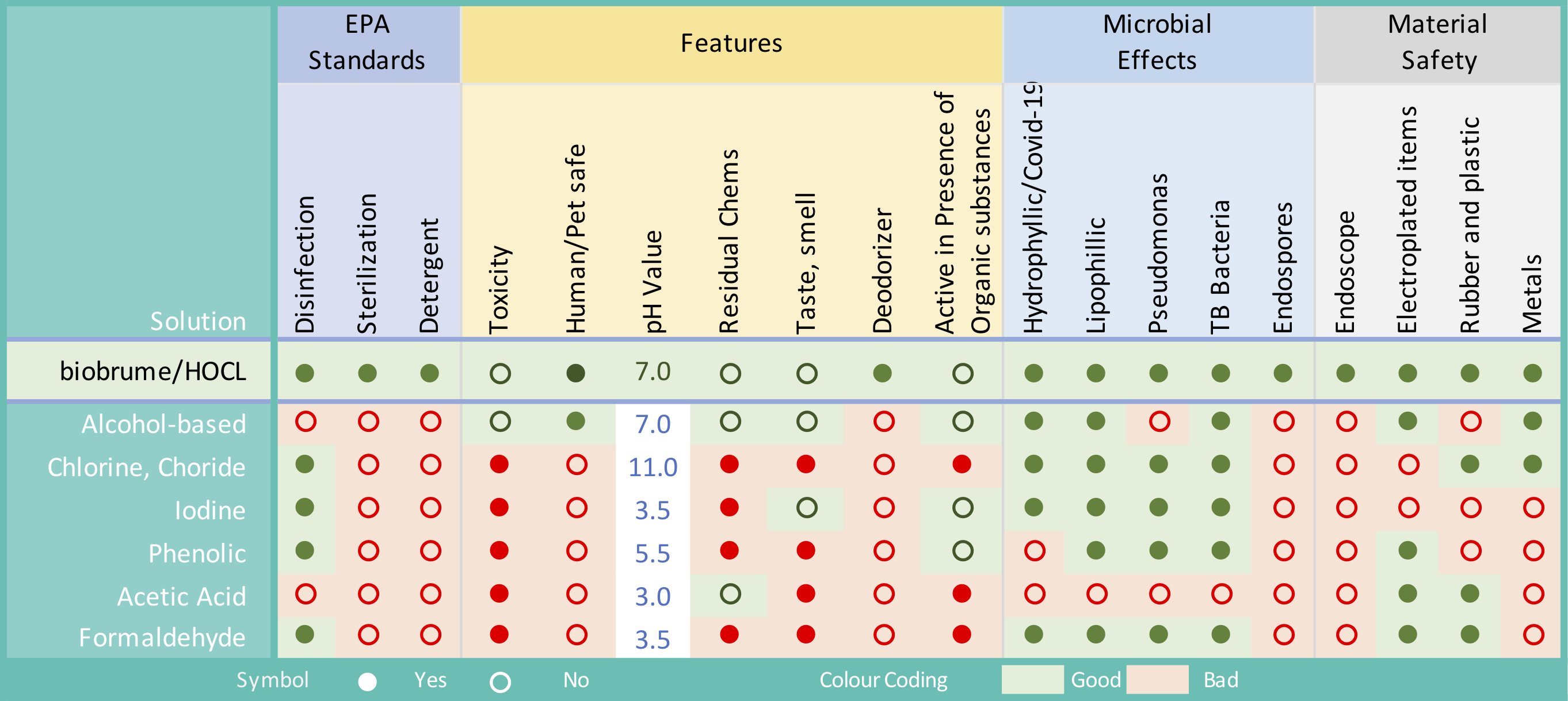Sheila Madan
Hypochlorous acid (HOCl) is an inexpensive, generally available, non-toxic, and practical disinfectant that is effective in sanitizing against the COVID-19 virus. This article reviews the evidence for using HOCl in the office, clinic, hospital or industrial setting on a daily basis. The method used to assemble recommendations was a review of the literature including evidence for this solution when used in different locations and industries.
HOCl is an endogenous substance in all mammals and is effective against a broad range of microorganisms. HOCl selectively binds with the unsaturated lipid layer and subsequently disrupts cellular integrity. Between pH levels of 3 and 6, the predominant species is HOCl that has maximal antimicrobial properties. In aqueous solution, it dissociates into H+ and OCl–, denaturing and aggregating proteins. HOCl also destroys viruses by chlorination by forming chloramines and nitrogen-centred radicals, resulting in single- as well as double-stranded DNA breaks, rendering the nucleic acid useless and the virus harmless.
The results indicate that HOCl can be used with high predictability for disinfecting against the COVID-19 virus. It is also extremely effective in sanitizing and disinfecting against the COVID-19 virus as well as multiple other microbes. It's almost pH neutral which makes it safe to use on most materials.
Effectiveness
HOCl has been shown to inactivate a variety of viruses including coronaviruses in less than 1 minute. It eradicates all bacteria, mycobacteria, spores, fungi, viruses – even the tough Clostridium difficile – within 15 seconds. It disinfects 200x to 300x better than sodium hypochlorite (NaHCl, or bleach) and is 100% non-toxic. At a concentration of 200 ppm, HOCl is effective in decontaminating inert surfaces carrying noroviruses and other enteric viruses, as well as bacteria, fungi and spores in a 1-minute contact time. When diluted 10-fold, HOCl solutions at 20 ppm are still effective in decontaminating environmental surfaces carrying viruses in a 10-minute contact time.
Comparison to Other Germicides
This comparison is from a different source and lends support to the claims made by the material in the linked article.
Personal, Office, Clinical & Other Applications
The authors also cover multiple use cases for HOCl in the article. These include, and are not limited to, the following.
- Hand Sanitizer
- HOCl specifically used for hand sanitizers is effective at 100- to 200-ppm strengths. HOCl is one of the most natural and effective known biocides known to man. It eradicates all bacteria, mycobacteria, spores, fungi, viruses – even the tough Clostridium difficile – within 15 seconds. It disinfects 200 to 300 times better than bleach and is 100% safe. It's incredibly effective in destroying all microbes within 60 seconds. It's therefore used extensively by medical professionals where they have to sanitise their hands multiple time an hour! It's the only thing that doesn't damage the skin.
- Surface Disinfection
- After cleaning, the rooms in the HOCl cleaning and disinfection study arm had significantly lower bacterial counts than the rooms that underwent standard cleaning and disinfection.
- Spray or Fogger
- HOCl fogs are highly effective in the microbial disinfection of surfaces. The fogging process can alter the physical and chemical properties of the disinfectant. pre-fogging adjustment of the concentration and pH of the solution makes it possible to control the concentration levels to the desirable range to inactivate pathogens after fogging. Link - Delta Airlines . Link - Cruise Ships .
- Pet Hygiene
- HOCl is particularly effective in sanitizing pets against all type of microbial infections. HOCl is harmless for use on pets and provides a safe mechanism for their cleaning. YouTube .
- Ophthalmology
- HOCl is used in the treatment of blepharitis by reducing the bacterial load on the surface of the periocular skin.
- Skin Care
- Being a natural, non-toxic and pH balanced liquid makes HOCl very effective for skin cleaning and maintenance. It reduces pimples, rashes, dry skin and mild to medium fungal infections. It's especially effective against athlete's foot and black toes. Many HOCl-based skincare products are available in the market. See this article , or this one or even this one for more information. Then there are the pages from product companies, Lumion , Curativa Bay and Purefresh . Biobrume makes a product for skincare, and though it's not listed there yet, it will soon be!
- Biofilm
- HOCl may be effective for cleaning biofilm-contaminated implant surfaces. Research article link .
- Mouth Rinse
- If HOCl is used as a mouth rinse, one must assume that a portion of the rinse will be swallowed. No abnormal findings were observed in terms of visual inspections of the oral cavity, histopathologic tests, or measurements of surface enamel roughness. HOCl can further also be used as a daily mouth wash as part of an individual's daily oral care routine. Research article (PDF) and another (PDF) .
- Clean Toothbrush
- HOCl significantly reduced bacteria on toothbrushes; it was effective as a mouthwash and for toothbrush disinfection. Research article (PDF) .
- Wound Care
- HOCl has been shown to be an effective agent in reducing wound bacterial counts in open wounds. We've published 2 articles regarding this topic, that can be found here (HOCl Is Ideal For Treating Wounds) and here (Biobrume For Wound Care & Scar Management) .
- Food Safety
- This germicide is used extensively in the food and produce packaging industry because it significantly reduces the spread of all types of microbes that otherwise multiply very quickly on raw meat. For fruits and vegetables, HOCl has been found to increase the shelf life of the produce. In the fishing industry, seafood is being packed in ice made of HOCl to increase shelf life.


